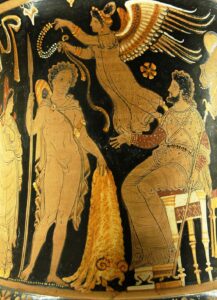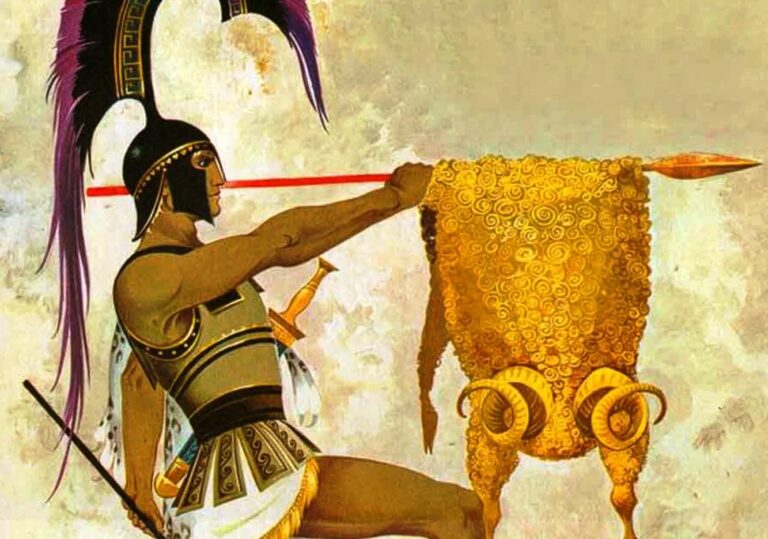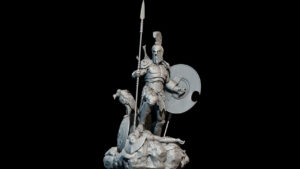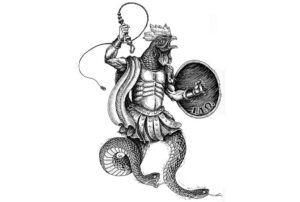Table of Contents
The Golden Fleece is the legendary fleece of a golden-winged ram, a central element in Greek mythology and the quest of Jason and the Argonauts.
Origin
In ancient Greek mythology, the Golden Fleece has a captivating origin. It begins with Nephele, a nymph created by Zeus.
Nephele’s children, Phrixus and Helle, faced a dire fate. Transitioning to their escape, Hermes sent a golden ram.
This remarkable ram, with its shimmering fleece, rescued Phrixus and Helle. They embarked on a journey over the sea.
Unfortunately, Helle didn’t survive, falling into the Hellespont. Nevertheless, Phrixus reached Colchis safely, where he sacrificed the ram to Zeus.
Transitioning to King Aeëtes, he received the ram’s fleece. The Golden Fleece, a symbol of divine intervention, gained prominence in Greek mythology.
Appearance

The Golden Fleece, described as the woolen fleece of a golden-winged ram, radiates a shimmering, golden hue. Transitioning to its mythical importance, it symbolizes kingship and possesses magical qualities. Guarded by a dragon in Colchis, obtaining it becomes the central quest for Jason and his heroic crew.
In artistic depictions, the Fleece is portrayed with a radiant and ethereal quality, glowing as a rare and divine object. Transitioning to its role in the narrative, the golden color signifies its significance and adds to the challenges faced by those seeking it in Greek mythology. Overall, golden-winged ram is envisioned as a precious and symbolic object, embodying both physical and mythical allure in the rich tapestry of Greek mythology.
Special powers
The Golden Fleece, with its special powers, stands as a mythical and revered object in Greek mythology.
Possessing a divine radiance, the fleece symbolizes kingship and holds mystical qualities. Transitioning to its origin, the gods provided a golden-winged ram whose fleece became the symbol of a heroic quest.
The fleece’s magical properties are evident in its ability to aid Phrixus and Helle’s escape. Moreover, transitioning to Jason’s quest, the fleece proves indispensable in overcoming Colchis’ challenges.
Medea, with her sorcery, amplifies the fleece’s powers, ensuring success in the quest for Jason and the Argonauts. As a symbol, the fleece is more than a physical entity; it represents the triumph of heroism and the divine.
The fleece’s impact extends beyond the mythical realm, inspiring artistic representations and cultural interpretations. Its symbolism endures, transcending time and continuing to captivate imaginations with its extraordinary and enchanting attributes.
Jason and the Argonauts
The myth of Jason and the Argonauts unfolds with intrigue and mythical allure, captivating readers with its adventurous narrative.
In the beginning, a prophecy sets the stage for King Pelias’ fear of a man wearing a single sandal. This fear propels Pelias to send Jason on an arduous quest for the Golden Fleece.
Assembling a formidable crew, Jason gathers legendary heroes such as Hercules, Castor, Pollux, and Orpheus. Together, they embark on the epic journey aboard the ship Argo.
The challenges intensify upon reaching Colchis, where King Aeëtes establishes daunting tasks, including taming fire-breathing bulls and confronting warriors sprung from dragon’s teeth.
In this perilous venture, Medea, a powerful sorceress and Aeëtes’ daughter, plays a pivotal role. Her assistance, driven by love for Jason, proves indispensable in overcoming Colchis’ trials.
Securing the coveted Golden Fleece from a dragon-guarded grove, Jason and the Argonauts face further perils on their homeward journey. Sirens, harpies, and the treacherous Symplegades test their mettle.
However, the narrative takes a tragic turn upon returning to Iolcus. Medea’s betrayal, driven by the consequences of her magical assistance, leads to the downfall of Pelias and a heartbreaking conclusion for the protagonists.
This enduring tale not only encapsulates heroism and mythical creatures but delves into complex themes of betrayal, loyalty, and the repercussions of pursuing ultimate power. The myth of the Golden Fleece continues to stand as a timeless and revered masterpiece in Greek mythology.




